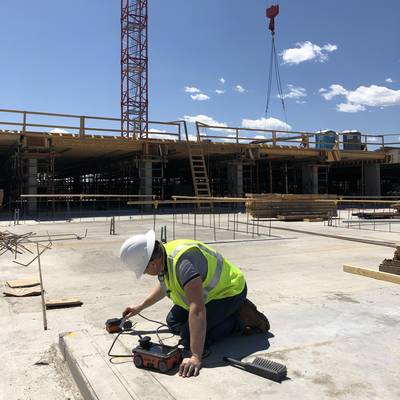Discover RainierGPR Service Areas for Reliable Concrete Scanning Solutions
Discover RainierGPR Service Areas for Reliable Concrete Scanning Solutions
Blog Article
Enhancing Project Planning and Execution With Advanced Concrete Scanning Strategies
In the world of job planning and execution, accuracy and foresight are important aspects that can make the difference in between success and obstacles. Advanced concrete scanning methods have become an innovative tool readied to elevate the requirements of project monitoring within the building and construction industry. By harnessing sophisticated technology, these methods offer a peek right into the architectural stability of a building even before the initial block is laid. The effects of such innovations are extensive, promising a standard change in how tasks are come close to and supplied.
Benefits of Advanced Concrete Scanning Strategies

Improved Precision in Project Evaluations
Enhancing task evaluations through sophisticated concrete scanning techniques substantially boosts the accuracy and dependability of building and construction assessments. By using sophisticated scanning innovations such as ground-penetrating radar (GPR) and 3D imaging, job teams can currently acquire comprehensive insights right into the condition of concrete frameworks, identifying possible defects or weaknesses that may not show up to the naked eye. This improved degree of precision in task evaluations allows building and construction professionals to make more educated decisions pertaining to fixing and maintenance strategies, causing improved general job results.
In addition, the increased precision in project analyses accomplished with sophisticated concrete scanning strategies helps in lessening the risk of unexpected concerns throughout the building and construction stage. By proactively detecting surprise anomalies within concrete structures, such as rebar rust or spaces, job groups can address these problems at an early stage, preventing costly hold-ups and remodel later in the task lifecycle. Eventually, the boosted accuracy in project evaluations promoted by sophisticated concrete scanning techniques adds to better performance, cost-effectiveness, and high quality in building tasks.
Very Early Recognition of Architectural Obstacles
Early detection of architectural difficulties plays a critical role in guaranteeing the integrity and safety and security of concrete frameworks throughout the construction process. Recognizing potential concerns at a beginning enables prompt intervention, protecting against costly rework, schedule hold-ups, and security Home Page hazards. Advanced concrete scanning techniques, such as ground-penetrating radar (GPR) and 3D imaging, make it possible for task groups to reveal covert problems, spaces, support format disparities, and other anomalies that can compromise the framework's stability.
By applying these techniques during the planning and implementation phases, building and construction specialists can proactively resolve architectural challenges prior to they escalate into significant troubles. As an example, identifying inadequate concrete cover over reinforcement bars at an early stage can prevent rust and architectural weakening in the long run - RainierGPR Service Areas. Moreover, recognizing variations in concrete thickness or density can aid maximize material use and make certain consistent stamina homes throughout the structure
Inevitably, very early identification of architectural obstacles through innovative concrete scanning not only enhances the total quality and resilience of the construction yet additionally adds to a more secure constructed environment for owners and customers.
Boosted Precaution in Building
The application of durable safety methods is essential in the building and construction industry to minimize threats and safeguard the health of stakeholders and employees. Building and construction websites are naturally unsafe atmospheres, with potential threats varying from drops and devices malfunctions to architectural failures. To improve precaution, construction companies are increasingly embracing technological developments such as wearable tools that keep track of employees' essential Look At This indicators and find potential health issues in real-time. Additionally, the use of drones for site security permits regular security evaluations without placing employees in injury's method. Safety and security training programs have additionally advanced to include virtual truth simulations that provide hands-on experience in handling emergency situation circumstances. Additionally, the assimilation of fabricated intelligence in security management systems enables proactive identification of potential risks, allowing for timely interventions. By prioritizing safety and security with the consolidation of sophisticated technologies and detailed training programs, building projects can dramatically minimize accidents and develop a safe and secure functioning setting for all entailed - RainierGPR Service Areas.
Streamlining Task Management Processes
To maximize operational effectiveness and ensure job success in the construction sector, a concentrate on simplifying project administration procedures is vital. By implementing effective task management procedures, building jobs can minimize delays, lower costs, and boost total productivity. One essential element of streamlining task management is the usage of advanced modern technologies such as Building Details Modeling (BIM) software program, which makes it possible for real-time partnership, clash discovery, and accurate job organizing. Additionally, the adoption of cloud-based job management systems enables smooth interaction among team members, immediate access to job data, and the capability to track development in real-time.

Verdict
In conclusion, the application of innovative concrete scanning strategies uses countless advantages for task preparation and execution. These strategies provide better accuracy in job analyses, early recognition of structural obstacles, improved safety procedures in building, and streamlined task administration processes. see here now Integrating these approaches right into job workflows can eventually lead to extra reliable and successful outcomes in construction tasks.
Inevitably, the improved accuracy in task analyses facilitated by innovative concrete scanning techniques contributes to greater efficiency, cost-effectiveness, and top quality in construction jobs. RainierGPR Service Areas.
To enhance functional effectiveness and ensure job success in the building and construction market, a focus on streamlining task administration procedures is important. By carrying out reliable job monitoring processes, construction jobs can reduce hold-ups, minimize prices, and boost general productivity. By simplifying project management processes via innovation assimilation, clear communication, and data-driven techniques, building and construction jobs can attain better efficiency, cost-effectiveness, and successful outcomes.
These methods offer improved accuracy in project analyses, early identification of architectural challenges, improved safety and security actions in building, and streamlined project monitoring processes.
Report this page